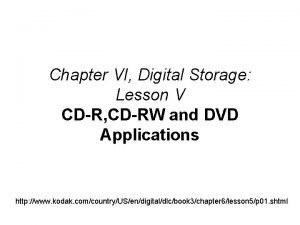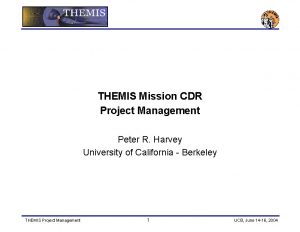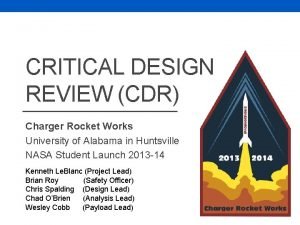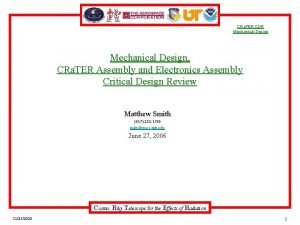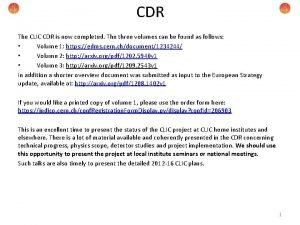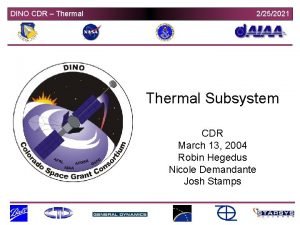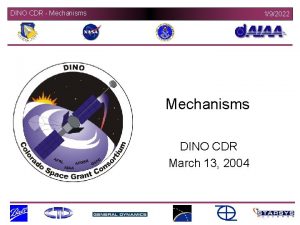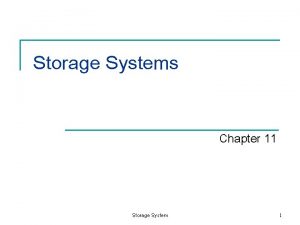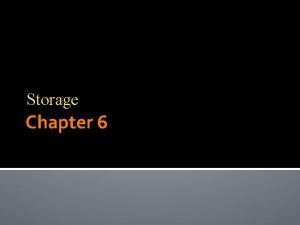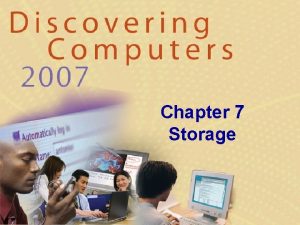Chapter VI Digital Storage Lesson V CDR CDRW











- Slides: 11

Chapter VI, Digital Storage: Lesson V CD-R, CD-RW and DVD Applications http: //www. kodak. com/country/US/en/digital/dlc/book 3/chapter 6/lesson 5/p 01. shtml

As a portable, removable media, and at a cost of just pennies per megabyte, optical storage discs have become a sensible, costeffective way for data to be stored, backed up, transported, shared, and archived. Contrasted with other media, CD-Rs and CD-RWs hold more information, for less. With CD-ROM drives becoming standard peripherals in computer systems, CDs have also become the best way to ensure cross-platform and multi-system compatibility.

Data and Image Archiving When images need to be stored on hard drives, space disappears fast. The higher the quality of a digital image, the more space it will consume, even today when hard-drive space is measured in gigabytes. A user could lower the quality of pictures by reducing overall size or pixels per inch … but in a time when inkjet photo printing is coming of age, that defeats the purpose of capturing highquality digital images.

With 650 MB of space, CD-Rs provide a low-cost way to archive images and important data for years. Even professional images of the highest quality can be accommodated, several dozen to a disc. And for good-quality consumer pictures from megapixel digital cameras, the number of archivable images per disc skyrockets. But, choose your media carefully. Typically, you get what you pay for. Media's that contain gold are best for images, because they last for a longer period of time.

Digital Audio Compilations The days of magnetic audio cassettes for music compilations are coming to a close. CD-Rs provide a faster, cheaper, and more convenient way to arrange favorite audio tracks. Audio CDs are easier to make, with a single writing session that records to disc at ten or twelve times the speed of a conventional, linear cassette recording. Not only are Audio CDs easier to create; they're easier to use. With the random-access capabilities of today's digital players, the audio. CD user can easily jump over 20 or 30 tracks and listen to a desired selection, in far less time than it takes an audio-cassette user to fast forward through a tape cassette.

Alternative Removable Storage Not all data needs to be archived for years. Preliminary drafts of ongoing projects, backups of system settings, digital comps and concepts … any number of computer-generated documents are vital for the short-term, but not needed after the completion of a project. CD-RWs are the perfect backup media for time-limited but task-critical back-up. Store ongoing work for several weeks, or several months. Then erase outdated information and record again. In time-limited backup situations, CD-RWs pay for themselves in just a few uses. They continue to rewrite data for well over 1, 000 rewrites.

Media Options: • Archivability: Final digital versions of a project? Good quality (usually containing real gold in the reflective layer) CD-R media have a longer storage life than any other commonly used media. You don't want to use CD-RW discs, which are not built for decades of storage • Mutability: Interim draft of a project, or a beta version of software in development? CD-RW could be your best bet, reusable for over a thousand drafts of the same information, if that's what it takes.

Compatibility: Circulating to a small group of computers with Multi. Read drives or current CDROMs? Definitely use CD-RWs. If you know discs will play, you're saving money at every disc exchange. • Distribution: Is your disc going out of house, likely to end up on multiple computers? CD-Rs are a better bet than CD-RWs. Be sure to take the format and file-system considerations in Lesson 4 into account before you burn your disc.

There any number of unique applications for recordable and rewritable CD media. Uses range from the commonplace to out-of-the-box examples: • Garage Bands: Turn your temporary stage into a temporary recording studio. Creating a homeband demo was once a costly enterprise. But with today's affordable recording equipment, you can create your own CDs for distribution. Who knows where your sound might end up? • School Reports: The use of videos for school projects has caught on. Why not take things a step further and present on-disc multimedia projects? Videos can be converted to digital format with an inexpensive capture board and easy-to-use software. Or keep it simpler with an on-disc photo essay using text and digital images. Simple multimedia tools come bundled in many systems. . . and you know you've been wanting to use them!

• Speech Distribution: Not everyone can make it to the big corporate meeting in Des Moines … so why not capture the keynote addresses and burn them to CD? "Audio CD" doesn't just mean music. Speeches on disc can communicate the true feeling of a presentation far better than a summary memo or email. • Work with the Web: Web developers can push the envelop with CD-R. Imagine a highbandwidth site, complete with music and video. Too much data for the pipeline? Then split the difference by loading high-bandwidth content to CD, and Web-enable the disc to import price lists, catalog updates, and breaking news right to the target audience's browsers. It's a direct mailer they won't forget.

The list of applications could continue, but you get the point. The single most important technology related to CD media is one we've always had … the wiring of the human brain. Perhaps it's time to stop referring to CDRs and CD-RWs as "optical storage media. " With the right applications, and a little imagination, they transform into "optical communications media" with endless possibilities.
